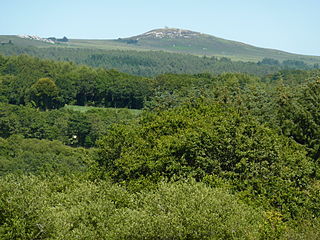
Breton is a Southwestern Brittonic language of the Celtic language group spoken in Brittany, part of modern-day France. It is the only Celtic language still widely in use on the European mainland, albeit as a member of the insular branch instead of the continental grouping.

Brittany is a peninsula, historical country and cultural area in the north-west of modern France, covering the western part of what was known as Armorica during the period of Roman occupation. It became an independent kingdom and then a duchy before being united with the Kingdom of France in 1532 as a province governed as a separate nation under the crown.

Ille-et-Vilaine is a department of France, located in the region of Brittany in the northwest of the country. It is named after its two main rivers, the Ille and the Vilaine. It had a population of 1,079,498 in 2019.

The Celtic Revival is a variety of movements and trends in the 19th, 20th and 21st centuries that see a renewed interest in aspects of Celtic culture. Artists and writers drew on the traditions of Gaelic literature, Welsh-language literature, and Celtic art—what historians call insular art. Although the revival was complex and multifaceted, occurring across many fields and in various countries in Northwest Europe, its best known incarnation is probably the Irish Literary Revival. Irish writers including William Butler Yeats, Lady Gregory, "Æ" Russell, Edward Martyn, Alice Milligan and Edward Plunkett stimulated a new appreciation of traditional Irish literature and Irish poetry in the late 19th and early 20th century.
"Bro Gozh ma Zadoù" is the anthem of Brittany. It is sung to the same tune as that of the national anthem of Wales, "Hen Wlad Fy Nhadau", and has similar lyrics. The Cornish anthem, "Bro Goth Agan Tasow", is also sung to the same tune.

Redon is a commune in the Ille-et-Vilaine department in Brittany in northwestern France. It is a sub-prefecture of the department.

France has one official language, the French language. The French government does not regulate the choice of language in publications by individuals, but the use of French is required by law in commercial and workplace communications. In addition to mandating the use of French in the territory of the Republic, the French government tries to promote French in the European Union and globally through institutions such as La Francophonie. The perceived threat from Anglicisation has prompted efforts to safeguard the position of the French language in France.
The culture of Brittany is the patterns of human activity and symbolism associated with the historical region of Brittany in northwestern France and the Breton people. Breton culture has been influenced by various local and nearby traditions over the centuries, including the Celtic culture of the Britons and Gauls and French culture to a lesser extent, particularly in Upper Brittany.

The Bretons are an ethnic group native to Brittany, north-western France. They trace their heritage to groups of Brittonic speakers who emigrated from southwestern Great Britain, particularly Cornwall and Devon, mostly during the Anglo-Saxon settlement of Britain. They migrated in waves from the 3rd to 9th century into Armorica, which was subsequently named Brittany after them.

Daoulas is a commune in the Finistère department of Brittany in north-western France.

Le Faou is a commune in the Finistère department of Brittany in north-western France.

Plouarzel is a commune in the Finistère department of Brittany in north-western France.

Saint-Rivoal is a commune in the Finistère department of Brittany in north-western France.
Ar Redadeg is a relay race modelled on the Basque Korrika. It takes place around Brittany over three days and three nights from Naoned (Nantes) to Karaez (Carhaix). Its aim is to raise funds each year to finance a project promoting the Breton language.
Stourm ar Brezhoneg is a Breton association founded in 1984 which calls for an official statute for the Breton language in public life.

Jean François Marie Le Gonidec de Kerdaniel was a Breton grammarian who codified the Breton language.
Ya d'ar brezhoneg is a campaign started in the 21st century by the Ofis ar Brezhoneg to promote and stimulate the use of the Breton language in daily life in Brittany, northwestern France. Breton is a Brythonic Celtic language which has fallen out of general use since the mid-20th century. Efforts are underway in the region to revive the language, which is classified by UNESCO as endangered.

Joseph-Marie Jaffré, better known as Job Jaffré, was a French journalist and Breton nationalist. He also published under pseudonyms, most notably as Jos Pempoull.
Al Liamm is a bimonthly magazine of culture and literature in the Breton language.

The Reunification of Brittany or Breton Reunification is a political movement to reunite the Loire-Atlantique department with the administrative region of Brittany, to form the entire cultural and historical region of Brittany. This "reunification" is considered a prerequisite for further Breton autonomy.














